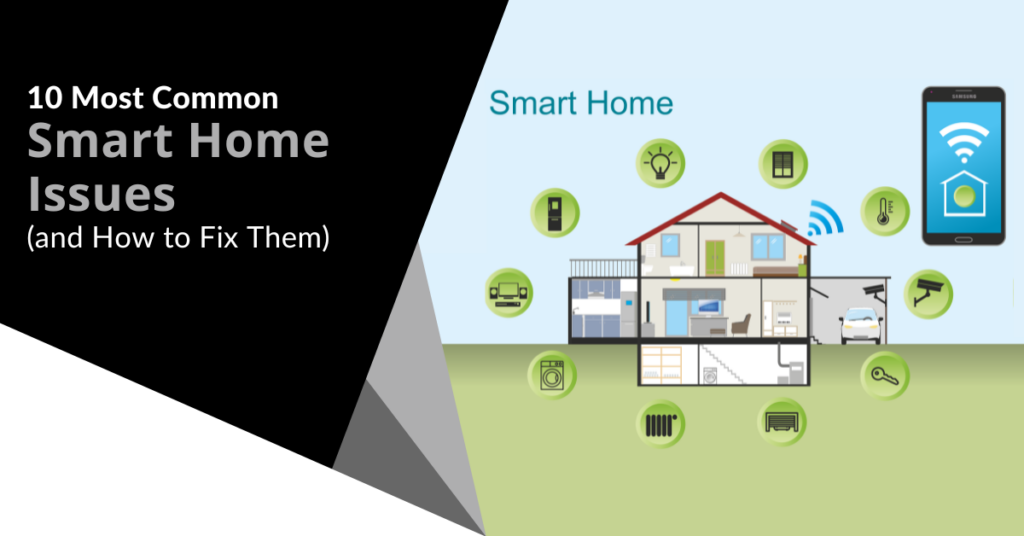|
Getting your Trinity Audio player ready...
|

Troubleshooting Common Smart Home Issues
When you were a child, the concept of living in a “smart home” might have seemed like something straight out of a sci-fi movie like Back to the Future II or The Jetsons. Although we’re still waiting on flying cars, we do have video calls, smart fridges, and voice-controlled lighting.
Yet, even the most cutting-edge technology isn’t immune to old-fashioned problems. Weak passwords can be exploited by hackers, and poor connections can reduce sophisticated devices to mere gadgets.
Have you encountered any hiccups with your smart home devices? Don’t worry! We’re here to help you resolve some of the most common issues and get your smart home running smoothly again.
Here are some frequent challenges and simple fixes to get things back on track.
1. Smart Home Connectivity Problems
Are your smart devices struggling to connect to Wi-Fi? The whole point of smart gadgets is their wireless accessibility. A solid internet connection is essential for integrating various devices into a cohesive smart home system.
If you’re facing connection problems, start with the basics. Restart your router and your devices. If that doesn’t solve the issue, check that your router is centrally located for optimal signal strength. For larger homes, consider using a mesh network or a Wi-Fi extender to ensure better coverage.
2. Unresponsive Smart Home Devices
With voice-activated devices becoming more common, we expect them to respond instantly. It can be frustrating when they don’t recognize their “wake word,” even after repeating it.
If your devices aren’t responding to commands, try a simple power cycle—turn them off and back on. Also, check for any software updates for both the devices and their corresponding apps. Updates often resolve bugs and enhance performance.
3. Battery Life Issues
Smart devices, especially those running on batteries, can experience rapid power drain. To extend battery life, adjust settings to minimize power consumption. Turn off features you don’t use, like notification lights or background updates. Using high-quality batteries can also make a noticeable difference.
4. Smart Home Compatibility Challenges
Not all smart devices work seamlessly together. Just because a device is labeled “smart” doesn’t mean it will integrate smoothly with your existing setup. When a new gadget doesn’t cooperate with your network, it can feel like a wasted investment.
Before purchasing a new device, ensure it’s compatible with your existing smart home ecosystem. Build your setup around a central platform, and thoroughly review the manufacturer’s specifications to avoid compatibility issues.
5. Smart Home Security Risks
Security is critical in a smart home, and there have been some alarming stories about hacked devices like baby monitors. It’s crucial to prioritize security rather than rushing to get everything set up.
Use strong, unique passwords for all your devices and accounts, and enable two-factor authentication where possible. Keep your devices and apps updated with the latest security patches.
Additional security tips include:
- Change the default name on your network to something less identifiable.
- Create a separate “guest” network for your smart devices to keep them isolated from sensitive data.
- Disable unnecessary sharing features, which are often enabled by default.
6. App Glitches
Experiencing intermittent issues with your smart home setup? The problem might be with the app itself.
Check for any available app updates and install them. Try logging out and back in to refresh the connection. If the problem persists, uninstall and reinstall the app to clear out any potential glitches.
7. Automation Errors
While smart home automations are incredibly convenient, they can sometimes malfunction. Review your automation rules to ensure they are set up correctly, and test each one individually to identify any faulty triggers or actions.
8. Range Limitations
Some smart devices have limited range, which can hinder communication. Check the manufacturer’s guidelines to understand the range limitations. Moving your devices closer to the hub or router can improve connectivity, or you might need repeaters or extenders if distance is an issue.
9. Random Activations
Have your smart lights ever turned on or off randomly? This could be due to several factors, such as:
- Accidental voice commands
- Malfunctioning sensors
- Forgotten scheduled automations
- A compromised device
Check your automation settings and disable any that aren’t necessary. Investigate whether your devices are picking up unintended commands, and be vigilant about changing passwords and monitoring for breaches.
10. Feeling Overwhelmed?
Managing multiple smart devices can be overwhelming. Don’t hesitate to consult the device manuals or online resources for guidance. You can also reach out to our IT experts for specific troubleshooting advice tailored to your situation.
Need Assistance Securing Your Smart Home?
A smart home is designed to simplify your life, not complicate it. These straightforward solutions can help resolve common issues. It’s also crucial to schedule a smart home security assessment to ensure your family’s safety.
Contact us today to arrange a security checkup for your smart home and enjoy greater peace of mind.
Twintel has grown into an expansive, full team of IT services professionals, acting as the outsourced IT department of non-profits, small to mid-size businesses, and enterprise-level corporations in Orange County, across California, and nationally.
Today, it’s the strength and deep expertise of the Twintel team that drives positive outcomes for clients. Each of the support staff, technicians, and engineers works diligently each day to make sure that the companies served have the seamless, secure, and stable IT environments needed to allow them to pursue their organizational objectives.